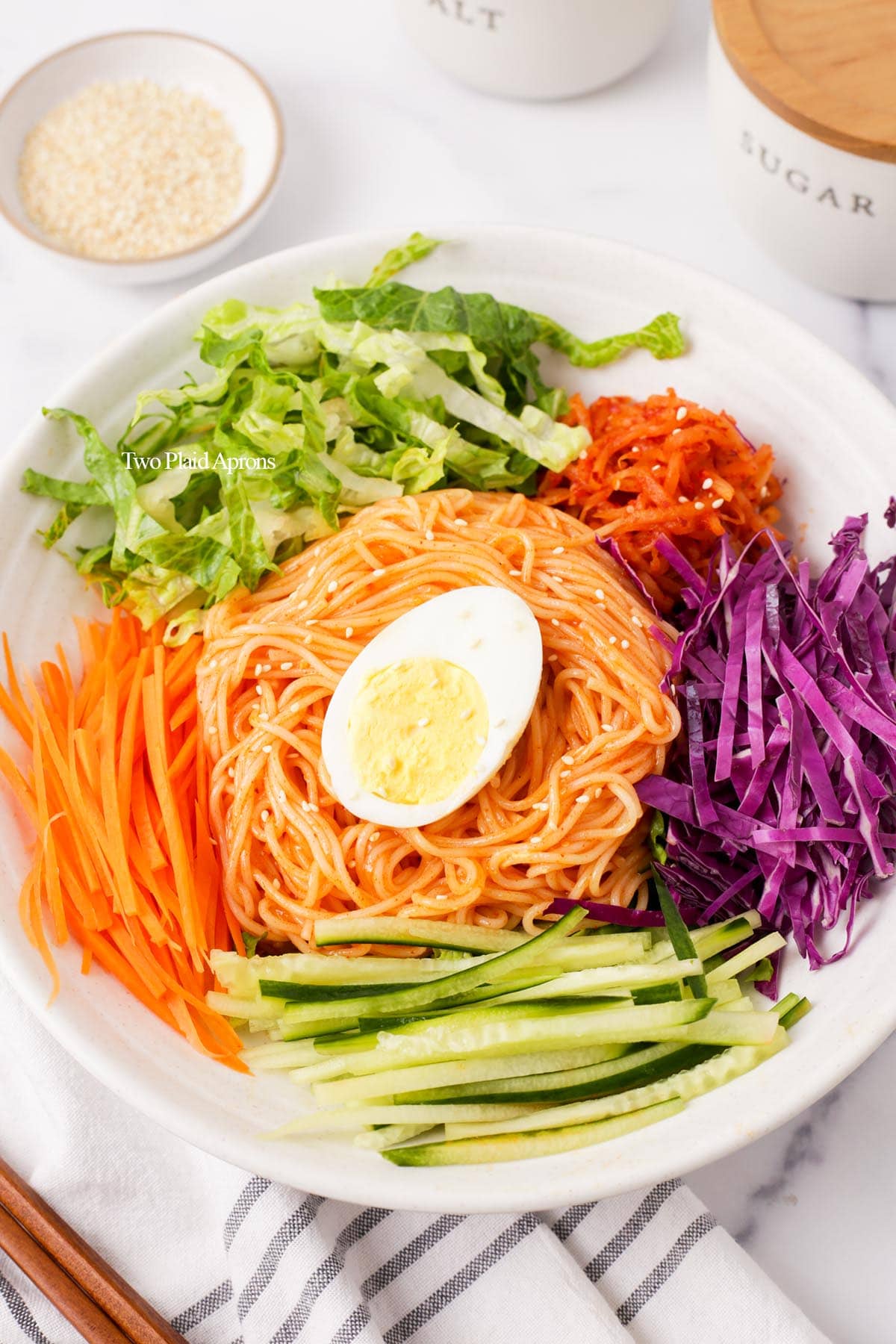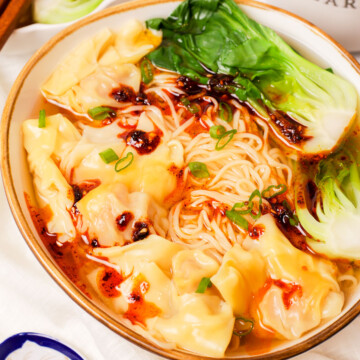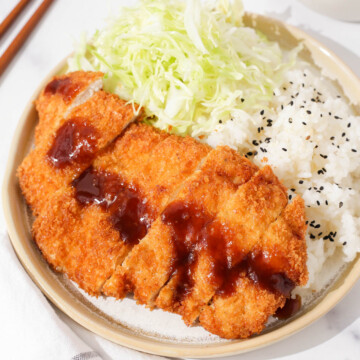Bibim guksu is a Korean spicy cold noodle dish made of somyeon noodles, a sweet, spicy, and tangy gochujang based sauce, and loaded with toppings like fresh vegetables, boiled egg, and kimchi. It's a super popular summer dish that you can easily make in 15 minutes!

This is one of Kyong's and his family's favorite spicy Korean noodles recipe because it's so flavorful and well balance. I have also come to enjoy it, but with a side of Yakult to help cool the spice, lol.
If you enjoy spice, you'll love bibim guksu as well. It's sweet, tangy, and spicy and loaded with tons of fresh vegetables so the dish stays light, refreshing, and perfect for the summer!
If you're looking for more spicy noodle dishes, we recommend our biang biang noodles and kimchi chili oil ramen. They are both amazing and fairly easy to make. For some non-spicy Korean noodle dishes, you may like our japchae (glass noodle stir fry) and jajangmyeon (black bean noodles).
Jump to:
What is bibim guksu?
Bibim guksu is Korean spicy noodle dish that's especially popular during the summer. "Bibim" means to mix, like in bibimbap (Korean mixed rice bowl). "Guksu" translates to noodles, and when a dish is called "guksu," it usually implies that the dish is made with wheat noodles.
This Korean spicy cold noodle dish is mixed with a spicy, sweet, and tangy gochujang based sauce. It's also slightly nutty from the sesame seeds and toasted sesame oil. Bibim guksu can be made with a variety of toppings from fresh vegetables to meat, hence why it's also sometimes called Korean spicy mixed noodle salad.

Ingredients
Please scroll down to the recipe card for the ingredient quantities!
- Somyeon noodles - These are wheat noodles that are thin, white, and round. You can find somyeon at most Asian markets where the dry noodles are.

- Egg - A boiled egg is usually served with bibim guksu. You can make it hard-boiled, medium, or soft-boiled.
- Fresh vegetables - Bibim guksu is very customizable in terms of which fresh vegetables you want to use. Our go to are lettuce (preferably green or romaine), english cucumber, purple cabbage, and carrot. Feel free to substitute or omit as you'd like.
- Kimchi (optional) - Kimchi adds extra tang and some funk to this Korean spicy noodle dish. You can add classic napa cabbage kimchi or radish kimchi.
- Gochujang - This is the base for making bibim guksu sauce. Depending on which brand of gochujang you use, they can vary a little in sweetness, spicness, and saltiness.
- White vinegar - Vinegar adds the nice tang in the sauce. We find that white vinegar taste the best.
- Sugar - For some additional sweetness in the sauce. You could also use honey if you prefer.
- Toasted sesame oil - In our opinion, toasted sesame oil is a big flavor profile for this dish. It adds a nutty, toasted flavor that makes bibim guksu taste really good.
- Toasted white sesame - Some toasted sesame seeds will be crushed and added to the sauce for extra nuttiness. You can do so with a sesame grinder (mortar and pestle) or using your finger. You can sometimes find already crushed sesame at the Asian markets as well.

How to make bibim guksu
1. For the fresh vegetables: Cut all the fresh vegetables into bite size strips, thinly sliced pieces, or matchstick size pieces so that it's easier to eat.
2. For the egg: Place the egg in a saucepan and fill it with enough water to cover the egg completely. Bring the water to a boil, then set a timer for 12 minutes for hard boiled egg, 8 minutes for medium boiled egg, or 6 minutes for soft boiled egg. Prepare a bowl of ice water and when the egg is done cooking, place the egg into the ice water to cool. Crack and peel the egg. Cut the egg in half and set aside until needed.
🌟Pro tip: Add about 1 to 2 tablespoons of white vinegar per 5 cups of water when boiling the egg. This will help make the egg easier to peel.
3. For the sauce: In a bowl, combine all of the ingredients for the sauce. Mix well and set aside until needed. *For the sesame seeds, you can crush it with a sesame grinder or with your fingers.*

4. For the somyeon noodles: Bring a pot of water to a boil and add the somyeon noodles. Let the noodles cook for 3 to 5 minutes, until just cooked, or according to the package instruction. Drain the noodles and rinse thoroughly with cold water while rubbing the noodles until completely cooled. Drain well and place the noodles into a mixing bowl.
5. Pour the prepared sauce over the noodles and mix well until the noodles are evenly coated.

6. Assemble the bibim guksu: In the serving bowl, place the prepared somyeon noodles at the bottom of the bowl. Pour any leftover sauce over the noodles as well.
7. Arrange all the prepared fresh vegetables and kimchi around the noodles and place the boiled egg on top of the noodles.
8. Serve: Garnish the bibim guksu with some sesame seeds if you wish. Mix everything up and enjoy! Optional, you could cut the noodles a couple of time with kitchen shears for easier eating.

Recipe tips
- Don't overcook the somyeon noodles. Overcooking will cause the noodles to turn mushy. Typically the noodles take only 3 to 5 minutes to cook. The texture of the noodles should be just tender but not mushy, and it should no longer taste starchy.
- Rinse the noodles well. Rinsing the noodles with cold water stops the cooking process and shocks the noodles. This keeps the noodles bouncy and chewy. You'll also want to rub the noodles in quick back and forth motion to help rinse away excess starch. This will prevent the noodles from clumping and tasting starchy.
- Feel free to use as much or as little vegetables as you like. You can also substitute and omit if you want to. But we do recommend having a generous amount of fresh veggies to keep the bibim noodles refreshing.

Storage
Bibim guksu is best enjoyed immediately or shortly after making because it is a noodle dish. Noodles will bloat and become soft as it sits. However, you can cut the fresh veggies, make the sauce, and boil the egg ahead of time so that you'll only have to prepare the somyeon noodles when you're ready to eat. If you have some leftovers, you could eat it later or the next day, just note that the noodles will most likely be soft.

FAQ
Bibim guksu and bibim naengmyeon are very similar. Both are spicy cold noodle dishes dressed with a sweet, spicy, and tangy gochujang based sauce. However, bibim guksu is made with wheat flour noodles, while bibim naengmyeon is made with chewy noodles that's made of flour, buckwheat, and starches.
Somyeon noodles are the noodles you want to use for bibim guksu. They are thin, white, round, and made of wheat flour. They're a little thinner than angel hair pasta. You can find somyeon at most asian markets where the dry noodles are sold.
Unfortunately, bibim guksu is known and loved for its spiciness. However, depending on which brand of gochujang you use, it can be a little less spicy. Personally, I use less sauce to make it less spicy, but it does make the dish a bit blander. Otherwise, you can try ganjang bibim guksu (soy sauce mixed noodles) instead.
If you’ve made this recipe or any recipes from our blog, please tag us on Instagram using #twoplaidaprons! You can also tag us in your Instagram stories using @two_plaid_aprons. We would love to see your creations! It absolutely makes our day! 🥰
📖 Recipe
Bibim Guksu (Korean Spicy Mixed Noodles)
Ingredients
For the bibim guksu:
- 3.5 ounces somyeon noodles (thin, round wheat noodles)
- 1 large egg
- ¼ english cucumber cut into thin matchstick pieces
- 2 leaves lettuce cut into ¼ inch strips
- ⅙ purple cabbage thinly sliced
- ⅓ large carrot peeled and cut into thin matchstick pieces
- ¼ cup kimchi classic napa cabbage or radish kimchi (optional)
For the sauce:
- 2 tablespoons gochujang (Korean red pepper paste)
- 1½ tablespoons white vinegar
- 1 tablespoon water
- 1 tablespoon sugar or honey
- 1½ teaspoon toasted sesame oil
- 1 teaspoon toasted white sesame crushed with your fingers or with a sesame grinder (plus more for garnishing)
Instructions
- For the egg:Place the egg in a saucepan and fill it with enough water to cover the egg completely. Bring the water to a boil, then set a timer for 12 minutes for hard boiled egg, 8 minutes for medium boiled egg, or 6 minutes for soft boiled egg. Prepare a bowl of ice water and when the egg is done cooking, place the egg into the ice water to cool. Crack and peel the egg. Cut the egg in half and set aside until needed.
- For the sauce:In a bowl, combine all of the ingredients for the sauce. Mix well and set aside until needed.
- For the somyeon noodles:Bring a pot of water to a boil and add the somyeon noodles. Let the noodles cook for 3 to 5 minutes, until just cooked, or according to the package instruction. Drain the noodles and rinse thoroughly with cold water while rubbing the noodles until completely cooled. Drain well and place the noodles into a mixing bowl.
- Pour the prepared sauce over the noodles and mix well until the noodles are evenly coated.
- Assemble the bibim guksu:In the serving bowl, place the prepared somyeon noodles at the bottom of the bowl. Pour any leftover sauce over the noodles as well.
- Arrange all the prepared fresh vegetables and kimchi around the noodles and place the boiled egg on top of the noodles.
- Serve:Garnish the bibim guksu with some sesame seeds if you wish. Mix everything up and enjoy! Optional, you could cut the noodles with kitchen shears for easier eating.
Notes
- Somyeon - These wheat noodles are thin, white, and round. You can find them in the dry noodle aisle at most Asian markets. If you prefer, you could use soba noodles instead.
- Vegetables - The vegetables for this spicy noodle dish is very customizable. Feel free to substitute and omit as you'd like. We do recommend using a variety of vegetables to add texture and flavor.
- Spiciness - How spicy the sauce is depends on the brand of gochujang you use. If you can't handle as much spicy, you can use less sauce. But it will make the dish a bit blander.
- Egg - If you want, add 1 to 2 tablespoons of white vinegar to the water when you boil the egg. This will help make the egg easier to peel.






















Comments
No Comments